Optimizing the Analytic Hierarchy Process through a Suitability Evaluation of Underground Space Development in Tonghu District, Huizhou City
1. Introduction
2. Research Methods and Basic Data
2.1. Research Methods
2.2. Basic Data
2.2.1. Regional Geological Conditions
(1) Lithology and intrusive rocks
(2) Fractures, folds, and geological disasters
(3) Ancient river channel (valley)
2.2.2. Hydrogeological Conditions
2.2.3. Engineering Geological Conditions
(1) Characteristics of bedrock
(2) Weak interlayer and its thickness and heterogeneity
(3) Bearing capacity of the foundation
3. Evaluation Process and Results
3.1. Establishing a Hierarchical Structure Model
3.2. Constructing Judgment Matrix
3.3. Hierarchical Single Ranking and Consistency Test
3.4. Hierarchical Total Sorting and Consistency Test
3.5. Suitability Classification of Underground Space
3.6. Suitability Division of Underground Space
4. Discussion
4.1. Expected Urban Development and Demand for Underground Space
4.1.1. Expected Urban Development Scale
4.1.2. Demand for Underground Space
4.2. Liveability of Cities
4.3. Problems and Suggestions of Comprehensive Evaluation
4.3.1. Problems of Comprehensive Evaluation
4.3.2. Relevant Recommendations
5. Conclusions
Author Contributions
Funding
Conflicts of Interest
References
- Tong, L.X. Sufficient Resource of Underground Space—for the City Development in 2lst Century. Undergr. Space 2000, 20, 1–5. [Google Scholar]
- Tong, L.X. Underground Space and Urban Modernization Development; Architecture & Building Press: Beijing, China, 2005. [Google Scholar]
- Tong, L.X. An Introduction to Underground Space (P.1). Undergr. Space 2004, 24, 133–136. [Google Scholar]
- Saaty, T.L. Relative measurement and its generalization in decision making why pairwise comparisons are central in mathematics for the measurement of intangible factors the analytic hierarchy/network process. Racsam Revista Real Acad. Cienc. Exactas Fisicas Nat. Serie A. Mat. 2008, 102, 251–318. [Google Scholar] [CrossRef]
- Jia, S.P.; Li, W.P. Review of Assessment of Urban Underground Space Resource. Chin. J. Undergr. Space Eng. 2008, 4, 397–401. [Google Scholar]
- Peng, J.; Peng, F. A GIS-based evaluation method of underground space resources for urban spatial planning: Part 1 methodology. Tunn. Undergr. Sp. Tech. 2018, 74, 82–95. [Google Scholar] [CrossRef]
- Sun, P.S. Introduction to Urban Geological Work; Geological Publishing House: Beijing, China, 2004. [Google Scholar]
- Cheng, G.H.; Zhai, G.Y. Guide to Urban Geological Survey in China; Science Press: Beijing, China, 2013. [Google Scholar]
- Zheng, G.S.; Wei, W.S.; Liu, Z.M.; Wang, J.M.; Yu, C.L.; Xu, J.X.; Li, X.L. Study on Theory of Urban Geology. Urban Geol. 2018, 13, 1–12. [Google Scholar]
- Zhuang, Y.X.; Cheng, G.H.; Zhai, G.Y. China’s urban geological work-protection of urban sustainable development. In Proceedings of the International Symposium on Urban Geology, Shanghai, China, 6–10 October 2010. [Google Scholar]
- Admiraal, H.; Cornaro, A. Why underground space should be included in urban planning policy—And how this will enhance an urban underground future. Tunn. Undergr. Sp. Tech. 2016, 55, 214–220. [Google Scholar] [CrossRef]
- Li, X.Z.; Li, C.C.; Parriaux, A.; Wu, W.B.; Li, H.Q.; Sun, L.P.; Liu, C. Multiple resources and their sustainable development in Urban Underground Space. Tunn. Undergr. Sp. Tech. 2016, 55, 59–66. [Google Scholar] [CrossRef]
- Peng, J.; Peng, F.L. A GIS-based evaluation method of underground space resources for urban spatial planning: Part 2 application. Tunn. Undergr. Sp. Tech. 2018, 77, 142–165. [Google Scholar] [CrossRef]
- Tong, L.X. A New Phase of Underground Space Development in China. Urban Stud. 2002, 9, 18–21. [Google Scholar]
- Zeng, W.T. A Review on the New Urbanization Studies. J. Hunan Univ. Arts Sci. Soc. Sci. Ed. 2008, 33, 48–51. [Google Scholar]
- Cheng, G.H.; Yang, Y.; Zhao, M.H.; Sun, J.W.; Li, Y.F. Strategic Thinking of Urban Geological Work in the New Era. Geol. Rev. 2018, 64, 1438–1446. [Google Scholar]
- Li, X.H.; Wang, H.T.; Yang, C.H.; Jia, J.Q.; Hu, G.Z. Discussion about Development and Utilization of Underground Space in Mountain City. Chin. J. Undergr. Sp. Eng. 2005, 1, 319–322. [Google Scholar]
- Admiraal, J.B.M. Think Deep: Planning, Development and Use of Underground Space in Cities; ISOCARP: The Hague, The Netherlands, 2015. [Google Scholar]
- Tengborg, P.; Sturk, R. Development of the use of underground space in Sweden. Tunn. Undergr. Sp. Tech. 2016, 55, 339–341. [Google Scholar] [CrossRef]
- Zhou, Y.; Zhao, J. Assessment and planning of underground space use in Singapore. Tunn. Undergr. Sp. Tech. 2016, 55, 249–256. [Google Scholar] [CrossRef]
- Hao, A.B.; Wu, A.M.; Ma, Z.; Liu, F.T.; Xia, Y.B.; Xie, H.L.; Lin, L.J.; Wang, T.; Bai, Y.N.; Zhang, J.; et al. A Study of Engineering Construction Suitability Integrated Evaluation of Surface-underground Space in Xiongan New Area. Acta. Geosci. Sin. 2018, 39, 513–522. [Google Scholar]
- Working Group No.4, International Tunnelling Association. Planning and mapping of underground space—An overview. Tunn. Undergr. Sp. Tech. 2000, 15, 271–286. [Google Scholar]
- Hou, X.Y.; Liu, K. Theory and Applications of Modern Urban Underground Space Planning. Chin. J. Undergr. Sp. Eng. 2005, 1, 7–10. [Google Scholar]
- ENAA, GEC. A Guide to Underground Space Utilization and Planning 2015; Asia Printing Office Co.,Ltd., Engineering Advancement Association of Japan: Tokio, Japan, 2016. [Google Scholar]
- Wallace, M.I.; Ng, K.C. Development and application of underground space use in Hong Kong. Tunn. Undergr. Sp. Tech. 2016, 55, 257–279. [Google Scholar] [CrossRef]
- Zhu, H.H.; Huang, X.B.; Li, X.J.; Zhang, L.Y.; Liu, X.Z. Evaluation of urban underground space resources using digitalization technologies. Undergr. Sp. 2016, 1, 124–136. [Google Scholar] [CrossRef]
- Shen, X.K.; Wang, J.H.; Han, X.; Zhou, H.L. The main geological risk and control countermeasures in underground space development of Beijing. In Proceedings of the National Security and Protection Engineering Conference, Beijing, China, 29 October 2010; pp. 137–145. [Google Scholar]
- Boivin, D.J. Underground space use and planning in the Quebec City area. Tunn. Undergr. Sp. Tech. 1990, 5, 69–83. [Google Scholar] [CrossRef]
- Ronka, K.; Ritola, J.; Rarhala, K. Underground space in land use planning. Tunn. Undergr. Sp. Tech. 1998, 13, 39–49. [Google Scholar] [CrossRef]
- Guan, S.Y.; Zhu, R.; Gao, Z.Y. Influence of geological conditions to the development and utilization of underground space in Wuhan and the subarea evaluation. Geotec. Invest. Surv. 2008, 9, 6–10. [Google Scholar]
- Ou, X.D.; Yang, R.C.; Zhou, D.; Ou, G. Application of AHP to Geological Environment Suitability Assessment in Nanning Underground Development. J. Guilin Uni. Tech. 2009, 29, 474–480. [Google Scholar]
- Liu, K.; Peng, J.; Peng, F.L. Evaluation model for the suitability of underground space resources exploitation and utilization. Chin. J. Undergr. Sp. Eng. 2011, 7, 219–231. [Google Scholar]
- Peng, J.; Liu, K.; Zhen, F.T.; Li, X.J.; Peng, F.L. Evaluation for the suitability of underground space exploitation and utilization based on AHP. Chin. J. Undergr. Sp. Eng. 2010, 6, 688–694. [Google Scholar]
- Chen, X.S. Research on Combined Construction Technology for Cross-Subway Tunnels in Underground Spaces. Engineering 2018, 4, 103–111. [Google Scholar] [CrossRef]
- Doyle, M.R. From hydro/geology to the streetscape: Evaluating urban underground resource potential. Tunn. Undergr. Sp. Tech. 2016, 55, 83–95. [Google Scholar] [CrossRef]
- Wilson, J.S.; Clay, M.; Martin, E.; Stuckey, D.; Vedder-Risch, K. Evaluating environmental influences of zoning in urban ecosystems with remote sensing. Remote Sens. Environ. 2003, 86, 303–321. [Google Scholar] [CrossRef]
- Zou, L.; Hu, Y.J.; Chen, Z.F.; Xie, Y.X. Underground Space Plan of Small and Medium-Sized City Based on Demand Oriented. Chin. J. Undergr. Space Eng. 2017, 13, 7–13. [Google Scholar]
- Seed, H.B.I.; Idriss, B.D.I. Simplified Procedure for Evaluating Soil Liquefaction Potential. J. Soil Mech. Found. Div. 1971, 97, 1249–1273. [Google Scholar]
- Saaty, T.L.; Vargas, L.G. Models, Methods, Concepts & Applications of the Analytic Hierarchy Process; Springer Science & Business Media: Berlin, Germany, 2012. [Google Scholar]
- Saaty, T.L. What is AHP/ANP. In Proceedings of the First Japanese Symposium on the Analytic Hierarchy Process, Meijo University, Nagoya, Japan, 5–8 December 2006. [Google Scholar]
- Saaty, T. L. Decision making with the analytic hierarchy process. Int. J. Serv. Sci. 2008, 1, 83–98. [Google Scholar]
- Saaty, T.L. How to make and justify a decision: The analytic hierarchy process. Part 1. Examples and Applications. Системні Дoслідження та Інфoрмаційні Технoлoгії 2002, 1, 95–108. [Google Scholar]
- Zhou, X.; Hu, Y.; Deng, Y.; Chan, F.T.S.; Ishizaka, A. A Dematel-based completion method for incomplete pairwise comparison matrix in AHP. Ann. Oper. Res. 2018, 271, 1045–1066. [Google Scholar] [CrossRef]
- Ishizaka, A.; Labib, A. Review of the main developments in the analytic hierarchy process. Expert Syst. Appl. 2011, 38, 14336–14345. [Google Scholar] [CrossRef]
- Gomez-Ruiz, J.A.; Karanik, M.; Pelaez, J.I. Estimation of missing judgments in AHP pairwise matrices using a neural network-based model. Appli. Math. Comput. 2010, 216, 2959–2975. [Google Scholar] [CrossRef]
- Saaty, T.L. Decision-making with the AHP: Why is the principal eigenvector necessary. Eur. J. Oper. Res. 2003, 145, 85–91. [Google Scholar] [CrossRef]
- Bruelli, M.; Canal, L.; Fedrizzi, M. Inconsistency indices for pairwise comparison matrices: A numerical study. Ann. Oper. Res. 2013, 211, 493–509. [Google Scholar] [CrossRef]
- Saaty, T.L.; Tran, L.T. On the invalidity of fuzzifying numerical judgments in the Analytic Hierarchy Process. Math. Comput. Model. 2007, 46, 962–975. [Google Scholar] [CrossRef]
- Hong, Z.G.; Li, Y.; Fan, Z.H.; Wang, Y. Caculation on High-ranked R.I. of Analytic Hierarchy Process. Comput. Eng. Appl. 2002, 38, 45–47. [Google Scholar]
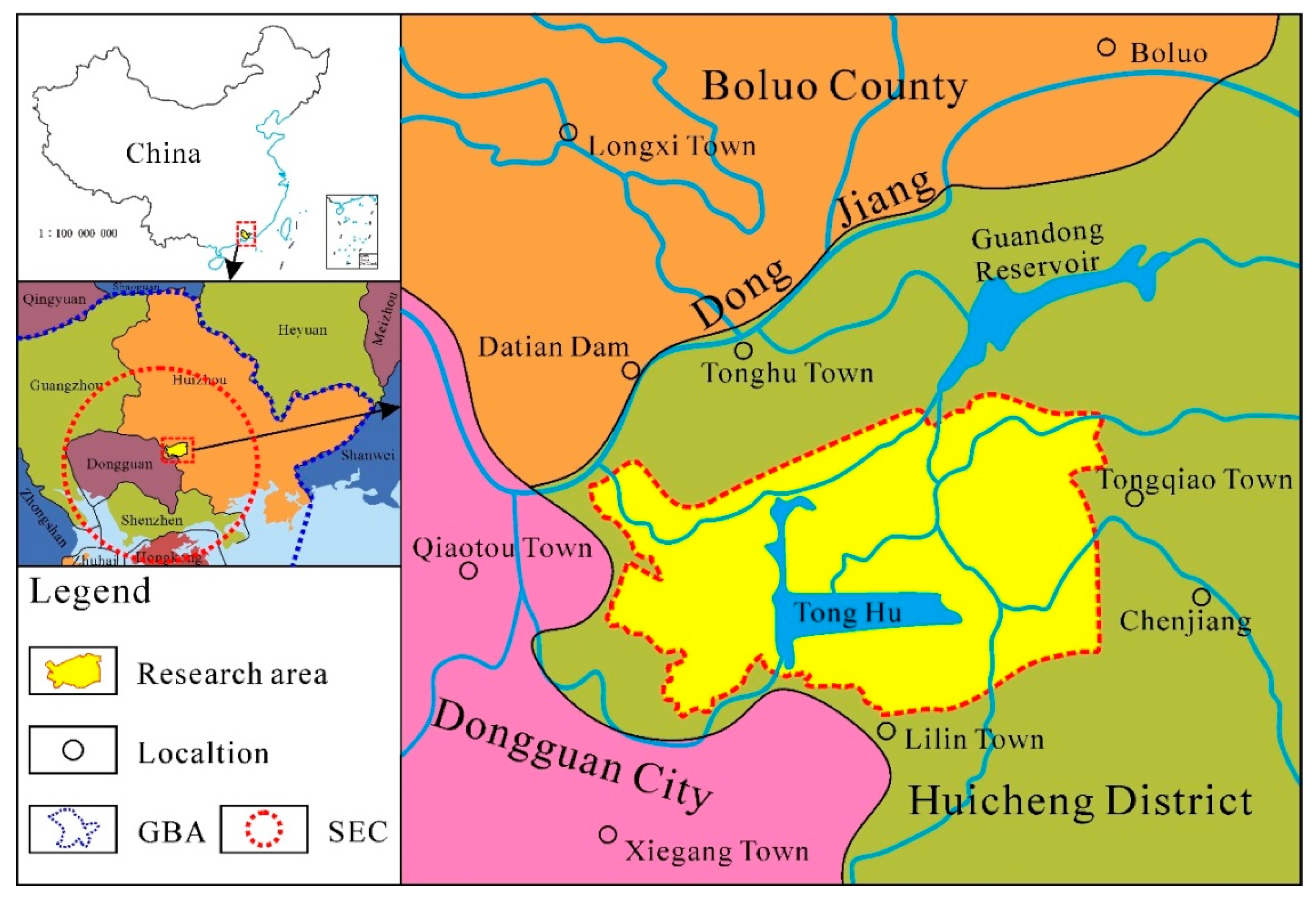
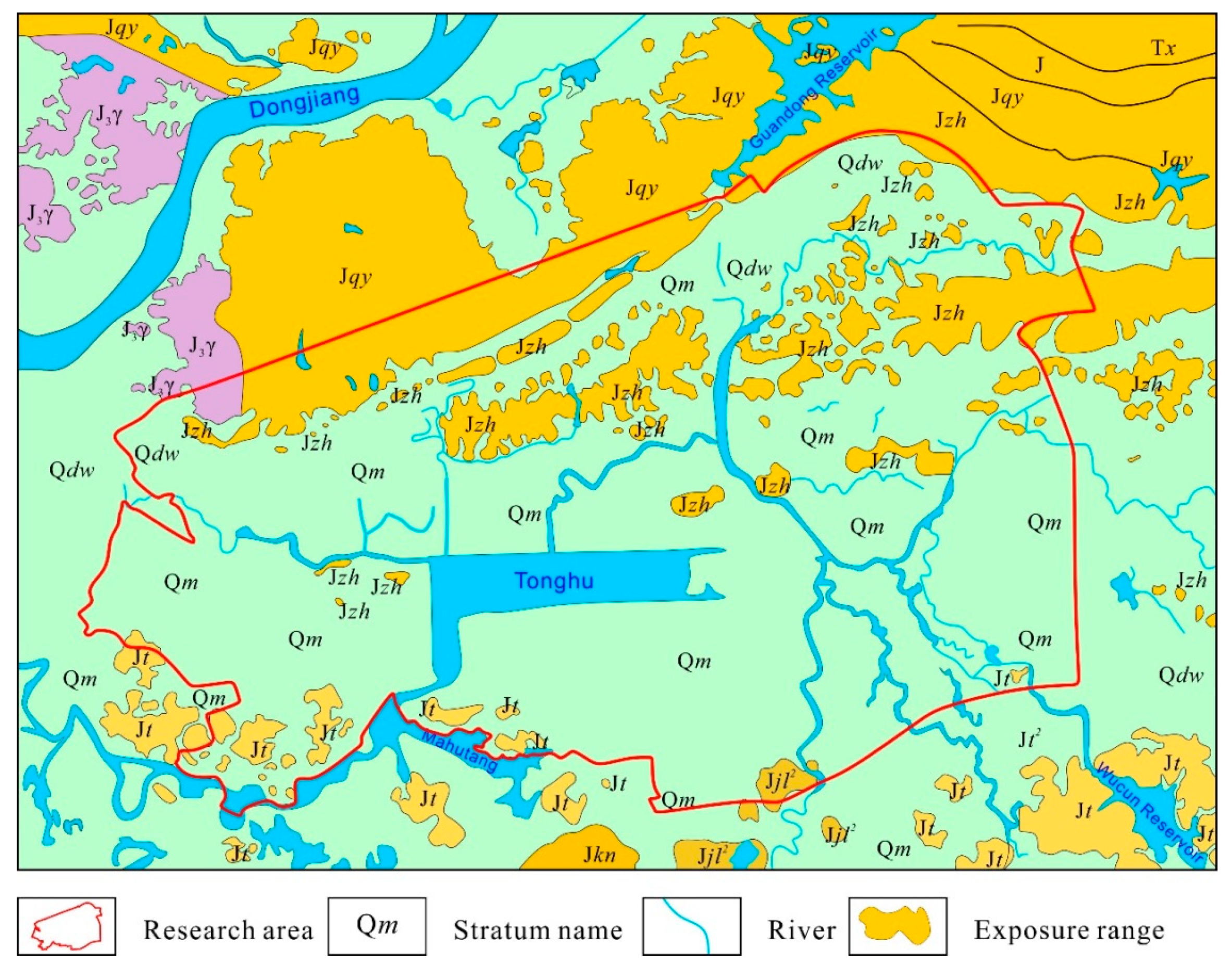
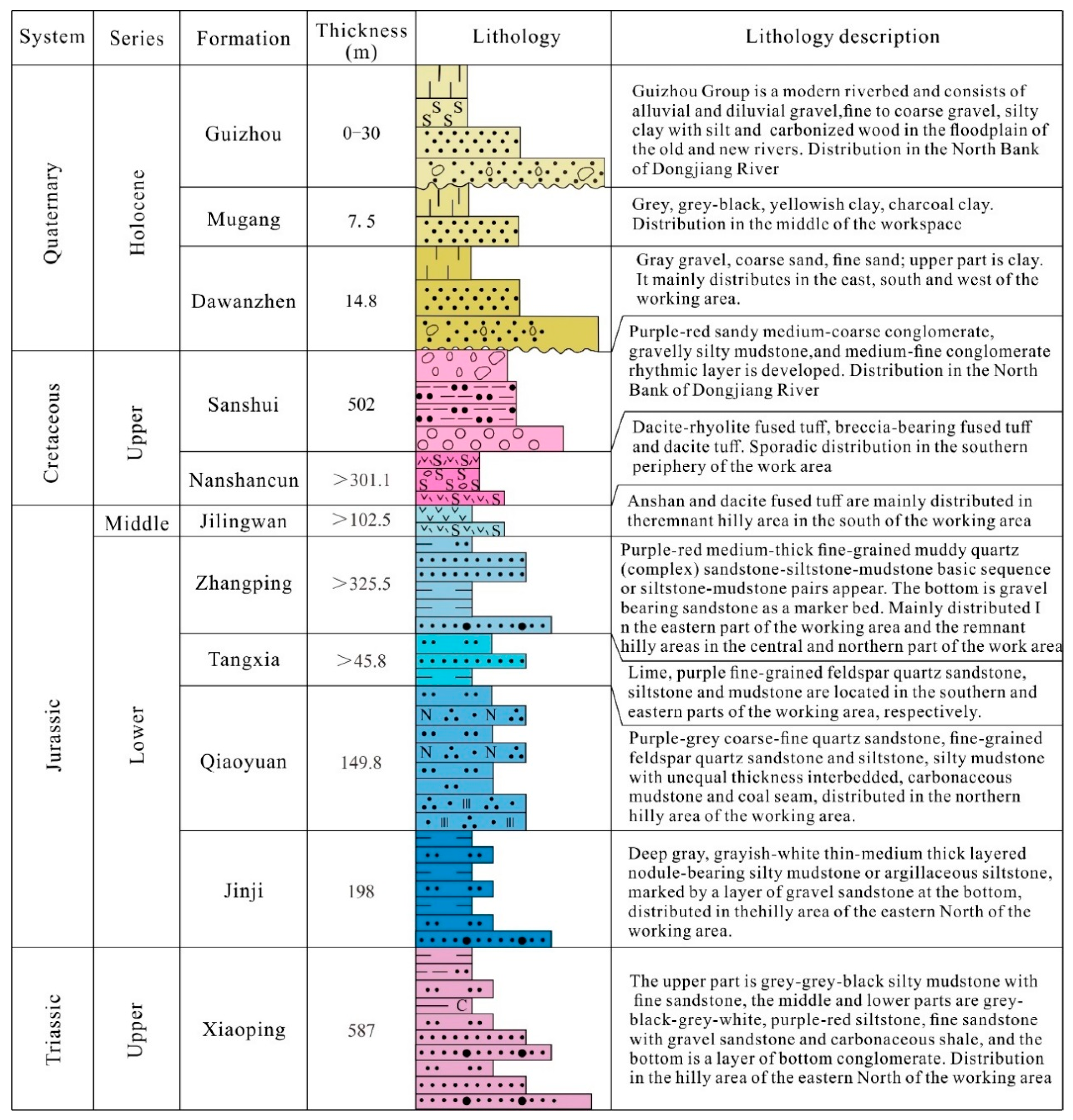


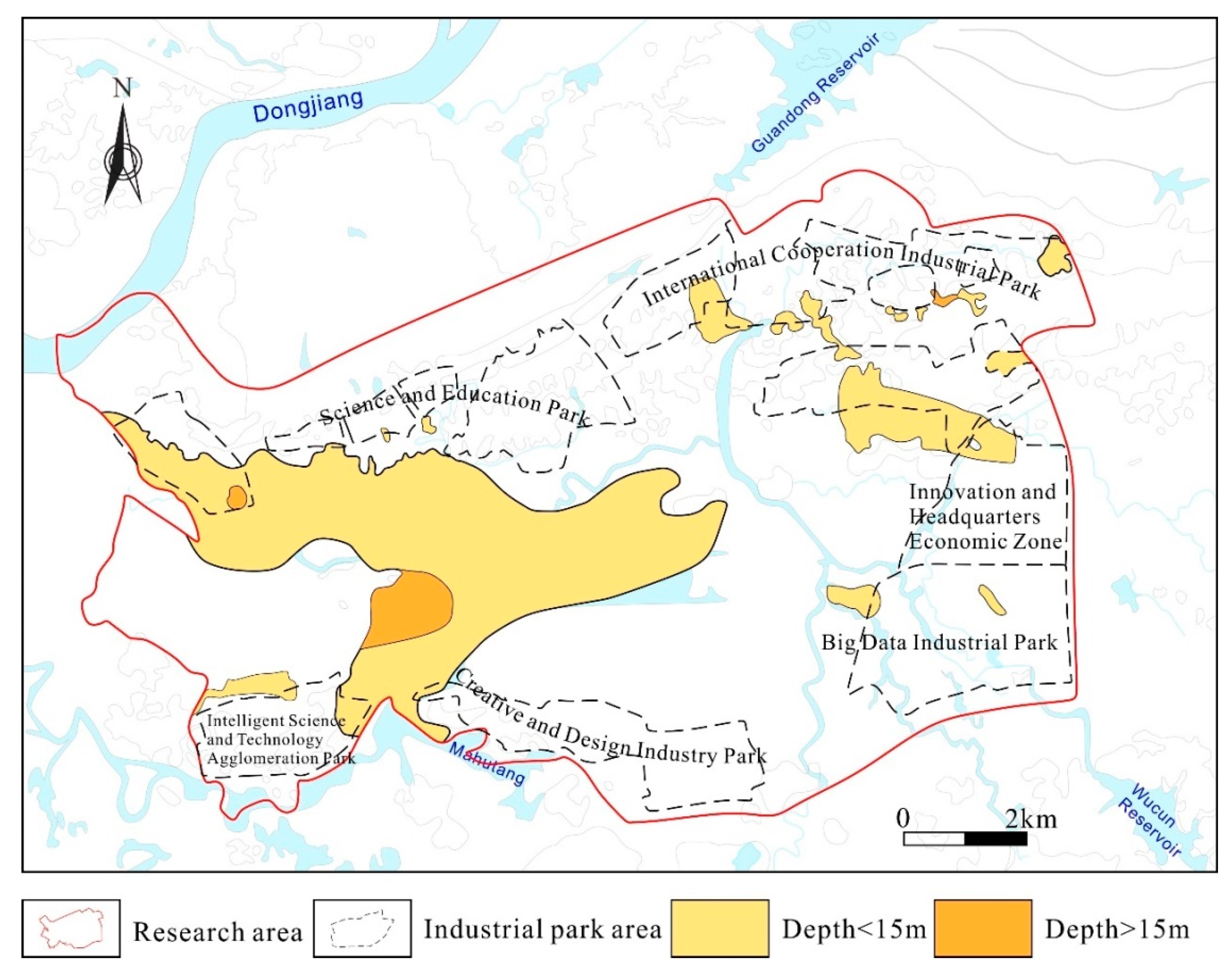


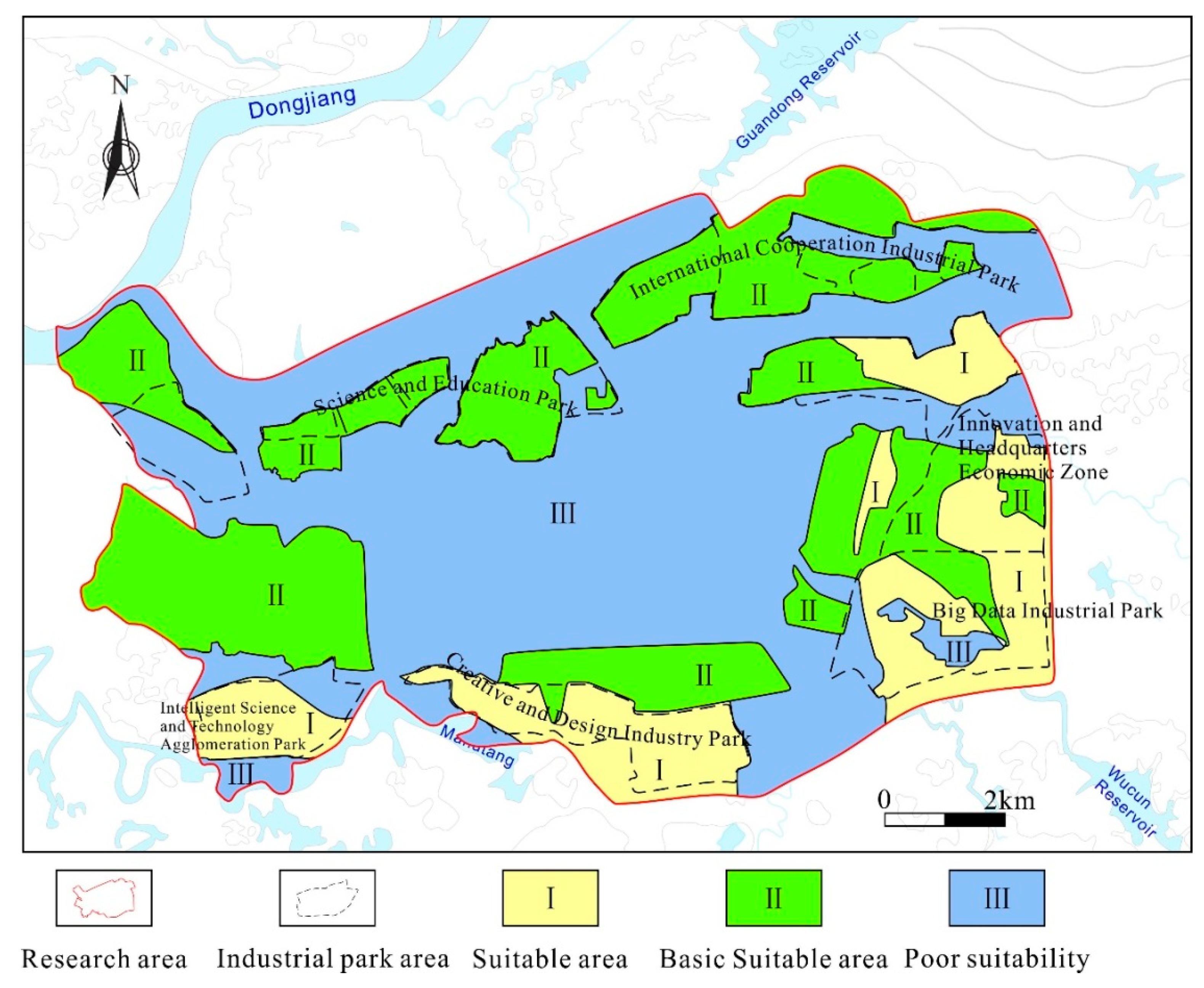
| Formation | Lithology | Buried Depth of Roof/m | Thicknes s/m | Weathering Degree | Eigenvalue of Bearing Capacity fak/kPa | Distribution |
|---|---|---|---|---|---|---|
| Jilingwan Formation | Ignimbrite | 16.5 | 1.5 | Complete weathering | - | South and southeast of Lilin Town |
| 11.5–18.0 | 4.2–11.5 | Strong weathering | - | |||
| 15.7–29.5 | 7.2–7.5 | Moderate weathering | - | |||
| Zhangping Formation | Quartz sandstone, siltstone, occasional mudstone, and glutenite | 0.5–38.5 | 0.9–27.25 | Complete weathering | 200–250 | Denudation dunes, medium-thick structure and sandy structure are mainly found in the central part of the basin. |
| 3.0–59.6 | 1.9–23.9 | Strong weathering | 300–350 | |||
| 9.7–79.1 | 1.7–50.5 | Moderate weathering | 500–600 | |||
| 23.1–153.4 | 1.0–71.1 | Gentle weathering | Muddy siltstone/siltstone 1500–2000 | |||
| Glutenite 2500–3000 | ||||||
| Tangxia Formation | Siltstone and argillaceous siltstone | 8.1–25.0 | 2.0–9.5 | Complete weathering | 200–250 | Most of the denudation mounds exposed in the south of the basin are independent, low-gentle mounds with medium-thick structure and sandy structure. |
| 12.0–34.5 | 2.3–26.5 | Strong weathering | 300–350 | |||
| 15.1–42.3 | 2.7–47.6 | Moderate weathering | 500–600 | |||
| 24.1–62.9 | 3.9–8.8 | Gentle weathering | 1500–2000 | |||
| Qiaoyuan Formation | Siltstone, argillaceous siltstone, local shale | 4.0–7.2 | 1.8–2.7 | Complete weathering | 200–250 | Hills on the north side of the basin with steep terrain |
| 5.8–40.0 | 2.0–18.5 | Strong weathering | 300–350 | |||
| 8.0–32.5 | 1.5–15.8 | Moderate weathering | 500–600 | |||
| 34.0–44.1 | 3.8–8.3 | Gentle weathering | 1500–2000 | |||
| Gongcun | Granite | - | - | Gentle weathering | 4500–5000 | Northwest of the study area |
| Types of Soil | Eigenvalue of Bearing Capacity fak (kPa) | Compressibility and Self-Stabilization |
|---|---|---|
| Artificial filling, cultivation, alluvial silt and silty soil in rivers and lakes | 60–80 | Highly compressible soil |
| Silty clay, clay, silt | 100–120 | Lower bearing capacity |
| Sand | 120–150 | Medium compressible soil, poor self-stability |
| Pebble | 150–180 | Medium compressible soil |
| Silty clay, silt (Piedmont zone) | 120–150 | Medium to highly compressible soil, poor self-stability |
| Residual silty clay | 180–200 | Medium compressible soil with a certain degree of self-stabilization |
| Suitability Evaluation | Engineering Geology | Hydrogeology | Regional Geology | Weight Wi | Characteristic Value λmax |
|---|---|---|---|---|---|
| Engineering geology | 1 | 3 | 9 | 0.6244 | 5.0774 |
| Hydrogeology | 1/3 | 1 | 1/5 | 0.1392 | 2.8352 |
| Regional geology | 1/9 | 5 | 1 | 0.2365 | 4.2362 |
| CI = (λ − n)/(n − 1) | 0.0165 | CR = CI/RI | 0.0131 | RI = 1.26 | |
| Orders | 1 | 2 | 3 | 4 | 5 | 6 | 7 | 8 | 9 | 10 | 11 |
|---|---|---|---|---|---|---|---|---|---|---|---|
| RI | 0 | 0 | 0.52 | 0.89 | 1.12 | 1.26 | 1.36 | 1.41 | 1.46 | 1.49 | 1.52 |
| Regional Geology | A1 | A2 | A3 | A4 | A5 | Weight Wi | Eigenvalue λmax |
|---|---|---|---|---|---|---|---|
| A1 | 1 | 1 | 3 | 1 | 5 | 0.3127 | 5.4533 |
| A2 | 1 | 1 | 2 | 1 | 2 | 0.2400 | 5.0854 |
| A3 | 1/3 | 1/2 | 1 | 1/3 | 1/2 | 0.0888 | 5.1165 |
| A4 | 1 | 1 | 3 | 1 | 1 | 0.2266 | 5.1968 |
| A5 | 1/5 | 1/2 | 2 | 1 | 1 | 0.1318 | 5.4509 |
| CI = (λ − n)/(n − 1) | 0.0652 | CR = CI/RI | 0.0582 | RI = 1.12 | |||
| Hydrogeology | B1 | B2 | B3 | B4 | B5 | Weight Wi | Eigenvalue λmax |
|---|---|---|---|---|---|---|---|
| B1 | 1 | 1 | 1/3 | 1/6 | 1/2 | 0.0919 | 5.7146 |
| B2 | 1 | 1 | 1 | 1 | 2 | 0.1875 | 5.4964 |
| B3 | 5 | 1 | 1 | 1 | 1 | 0.2349 | 5.0496 |
| B4 | 6 | 1 | 1 | 1 | 1 | 0.2945 | 5.4198 |
| B5 | 2 | 1/2 | 1 | 1 | 1 | 0.1621 | 5.2278 |
| CI = (λ − n)/(n − 1) | 0.0954 | CR = CI/RI | 0.0852 | RI = 1.12 | |||
| Engineering Geology | C1 | C2 | C3 | C4 | C5 | Weight Wi | Eigenvalue λmax |
|---|---|---|---|---|---|---|---|
| C1 | 1 | 1 | 1 | 4 | 5 | 0.2922 | 5.1859 |
| C2 | 1 | 1 | 2 | 6 | 5 | 0.3641 | 5.0386 |
| C3 | 1 | 1/2 | 1 | 2 | 3 | 0.2000 | 5.2310 |
| C4 | 1/4 | 1/6 | 1/2 | 1 | 1/3 | 0.0594 | 5.4071 |
| C5 | 1/5 | 1/5 | 1/3 | 3 | 1 | 0.0843 | 5.4608 |
| CI = (λ − n)/(n − 1) | 0.0662 | CR = CI/RI | 0.0591 | RI = 1.12 | |||
| First grade Index ai | Regional Geology | Hydrogeology | Engineering Geology | General Ranking |
|---|---|---|---|---|
| 0.1945 | 0.0959 | 0.7096 | ∑aibin | |
| Second index bin | 0.3127 | 0.0919 | 0.2922 | 0.2770 |
| 0.2400 | 0.2162 | 0.3641 | 0.3258 | |
| 0.0888 | 0.2344 | 0.2000 | 0.1817 | |
| 0.2266 | 0.2693 | 0.0594 | 0.1121 | |
| 0.1318 | 0.1882 | 0.0843 | 0.1035 | |
| CIi | 0.0652 | 0.0954 | 0.0662 | CI = ∑aiCIi = 0.0688 |
| RIi | 1.12 | 1.12 | 1.12 | CI = ∑aiRIi = 1.12 |
| CRi | 0.0582 | 0.0852 | 0.0591 | CR = CI/RI = 0.0614 |
| First Grade Index | Second Index | Most Suitable | More Suitable | Less Suitable | Evaluation Score | Evaluation Level |
|---|---|---|---|---|---|---|
| Regional geology | Lithology | √ | 2.58 | Most suitable | ||
| Faults and folds | √ | |||||
| Palaeochannels | √ | |||||
| Geological hazard | √ | |||||
| Ground fissure | √ | |||||
| Engineering geology | Bedrock features | √ | 3 | Most suitable | ||
| Bearing capacity of foundation | √ | |||||
| Sand liquefaction | √ | |||||
| Soft layer features | √ | |||||
| Land subsidence | √ | |||||
| Hydrogeology | Surface water distribution | √ | 1.74 | More suitable | ||
| Groundwater distribution | √ | |||||
| Aquifer lithology | √ | |||||
| Aquifer permeability | √ | |||||
| Characteristic of supplementary drainage | √ |
| Index | 2025 Year | 2030 Year |
|---|---|---|
| Permanent population (10,000 people) | 15 | 25 |
| Per capita residential land (m2/person) | 20.24 | 18.86 |
| Per capita scale of construction land (km2/10,000) | 1.67 | 2 |
| Per capita park green space area (m2/person) | 20 | 25 |
| Percentage of forest cover (%) | 65 | 65 |
| Total land use (km2) | 141.56 | 149.81 |
| Intelligent area of Tonghu (km2) | 128 | |
| Demand for underground space resources (km2) | 13.56 | 21.81 |
| Building Grade | Height/m | Predicting the Depth of Foundation /m | Predicting the Influence Depth of Foundation /m | Architectural Uses |
|---|---|---|---|---|
| First level | >100 | >8.3 | >10 | Station, TOD plot, landmark building |
| Second level | 75–100 | 6.25–8.3 | 8.25–10.3 | Grouped plots, land for public facilities and residential land |
| Level three | 45–75 | 3.75–6.25 | 5.75–11.25 | Industrial and service life groups and construction land of villages and towns |
| Level four | 24–45 | 2–3.75 | 4–5.75 | Industrial groups and planning for additional industrial land |
| Level five | 9–24 | 0.75–2 | 2.75–4 | Scenic spots, villas, municipal utilities, schools |
© 2020 by the authors. Licensee MDPI, Basel, Switzerland. This article is an open access article distributed under the terms and conditions of the Creative Commons Attribution (CC BY) license (http://creativecommons.org/licenses/by/4.0/).
Share and Cite
Zhang, X.; Wang, C.; Fan, J.; Wang, H.; Li, H. Optimizing the Analytic Hierarchy Process through a Suitability Evaluation of Underground Space Development in Tonghu District, Huizhou City. Energies 2020, 13, 742. https://doi.org/10.3390/en13030742
Zhang X, Wang C, Fan J, Wang H, Li H. Optimizing the Analytic Hierarchy Process through a Suitability Evaluation of Underground Space Development in Tonghu District, Huizhou City. Energies. 2020; 13(3):742. https://doi.org/10.3390/en13030742
Chicago/Turabian StyleZhang, Xiaobo, Chengshan Wang, Jie Fan, Huijun Wang, and Hailong Li. 2020. "Optimizing the Analytic Hierarchy Process through a Suitability Evaluation of Underground Space Development in Tonghu District, Huizhou City" Energies 13, no. 3: 742. https://doi.org/10.3390/en13030742
APA StyleZhang, X., Wang, C., Fan, J., Wang, H., & Li, H. (2020). Optimizing the Analytic Hierarchy Process through a Suitability Evaluation of Underground Space Development in Tonghu District, Huizhou City. Energies, 13(3), 742. https://doi.org/10.3390/en13030742




